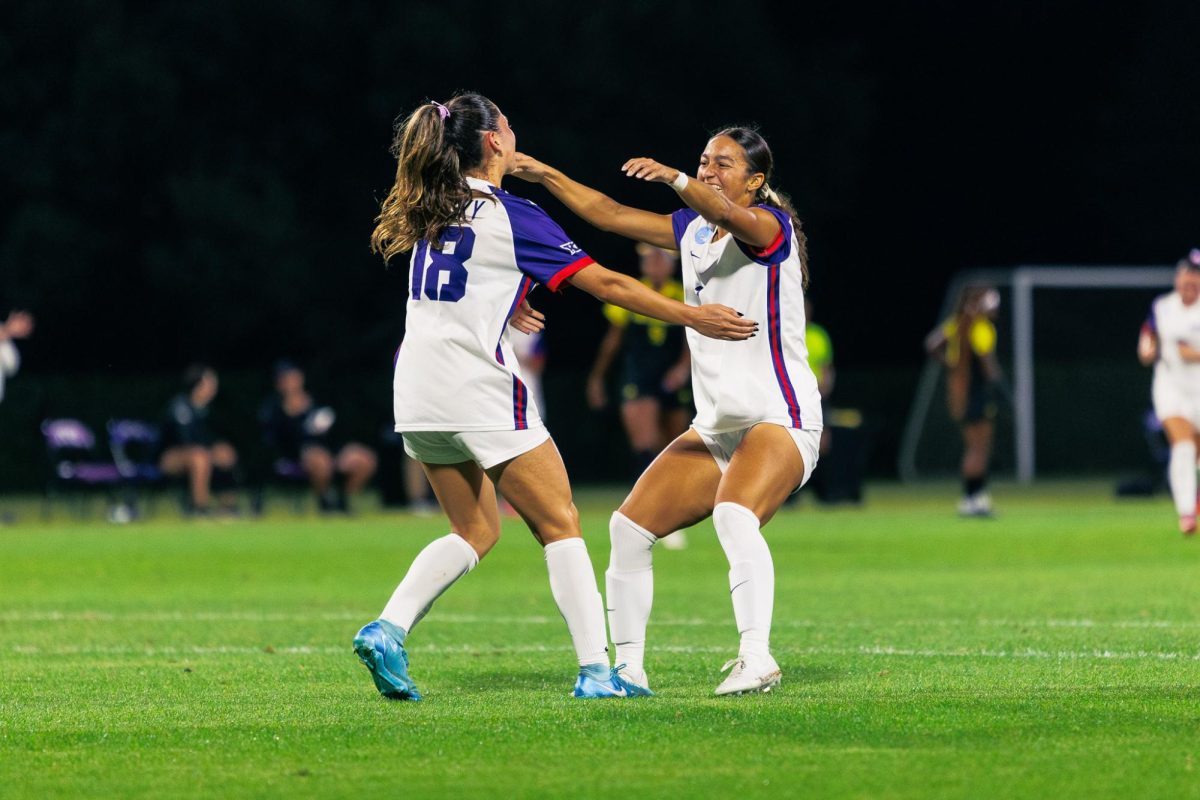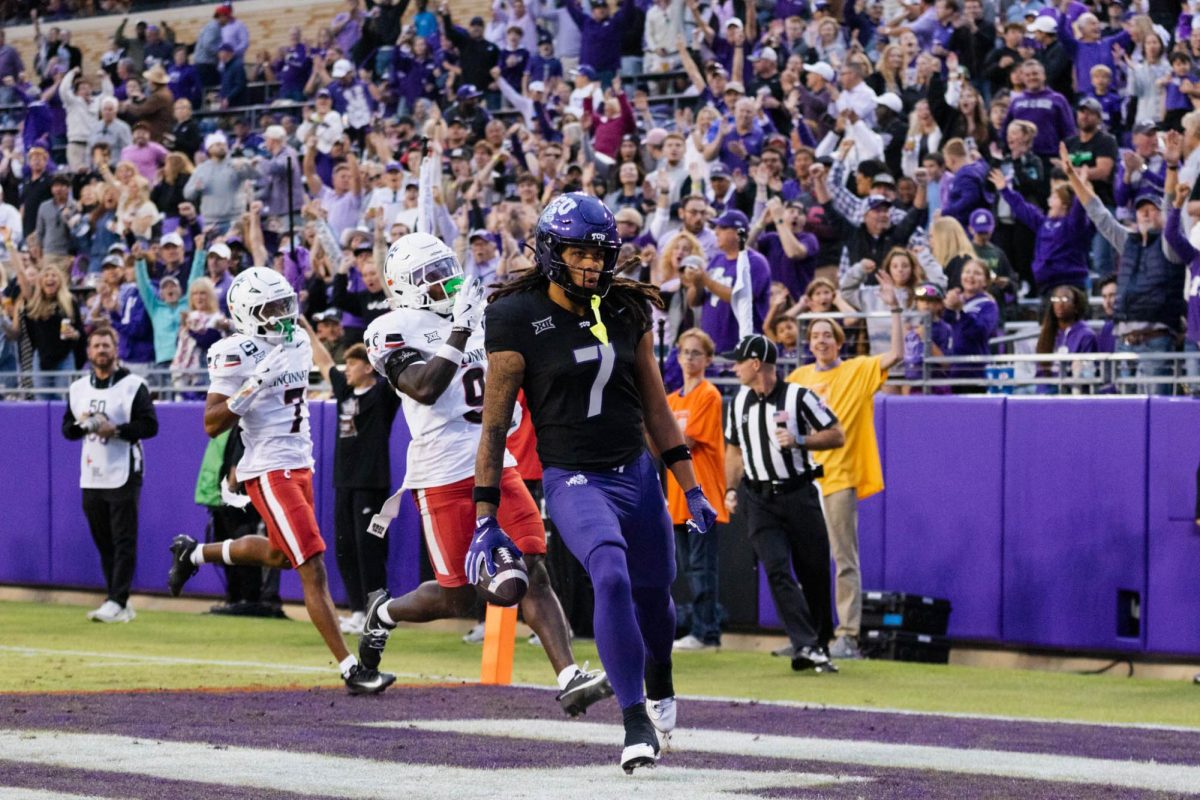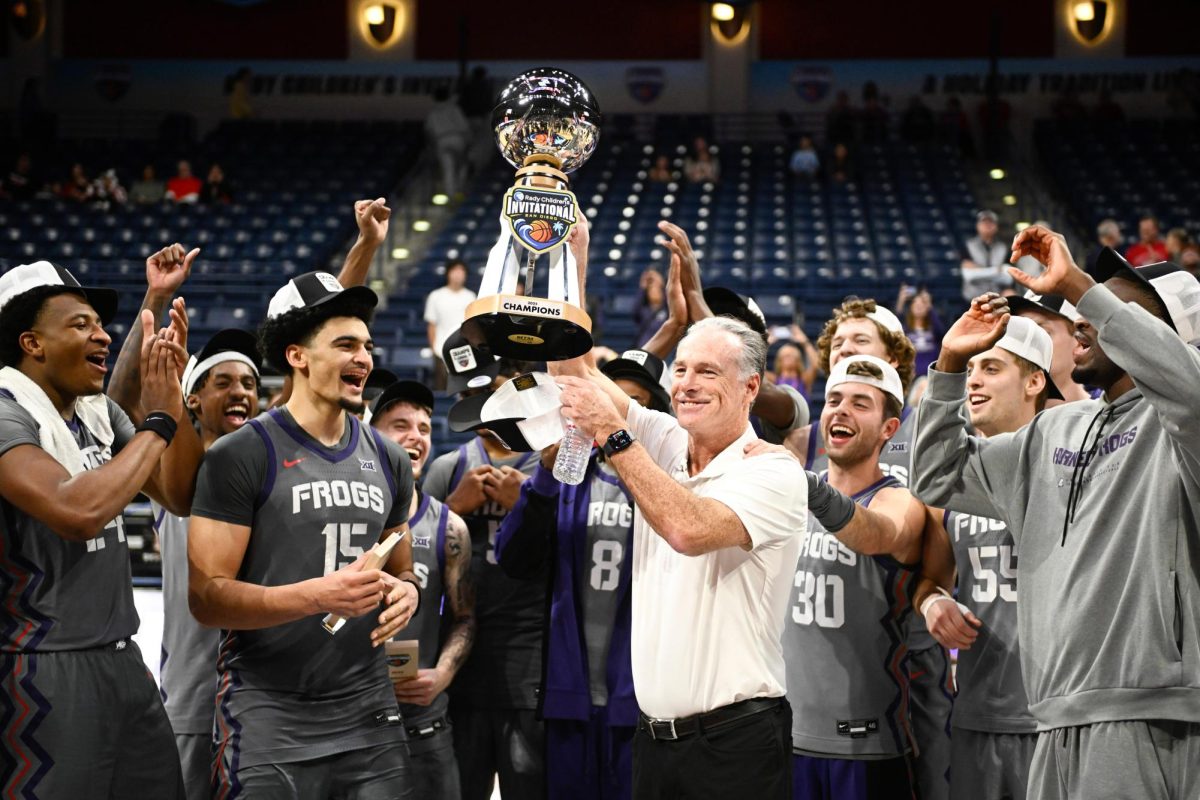For all the intangible benefits afforded to TCU by joining the Big 12, there’s been one entirely tangible asset the Horned Frogs have taken advantage of in their new league.
Money.
Nearly two years after announcing its move to the Big 12, TCU Athletics has cashed in on record ticket sales, increased revenues through conference distribution revenues and a healthy stream of merchandise sales.
And according to associate athletics director Jack Hesselbrock, there’s a “very good chance” the department will see a profit in five years.
The impact of simply being in the Big 12 has been huge.
“It’s been substantial,” said Hesselbrock, who serves in a CFO-type role for TCU Athletics. “I mean, just in our first year, we’re talking six or seven times the amount (of revenue) just by being in the Big 12 – without even going to a bowl, without even doing anything – just the membership itself.”
TCU’s cut from its first year in the Big 12 was $11 million, according to Forbes. The Big 12 announced this spring it would distribute a record $198 million among the league’s 10 schools. TCU and West Virginia received half of what the other eight schools collected as part of a half-share agreement between the two schools and the league.
But that ends in 2016, when TCU starts getting a full cut of the league revenues.
On top of that, TCU’s season ticket sales have more than doubled since 2009, when the school sold 13,000, according to the Fort Worth Star-Telegram.
This year, TCU sold 31, 636, eclipsing last season’s record mark of 31,282, according to TCU Athletics.
Off the field and outside of the stadium, TCU, one of the smallest BCS conference schools, is carving a spot into collegiate apparel market, which in 2012 was estimated at $4.62 billion, according to the Collegiate Licensing Company. The Frogs ranked 36th nationally in sales, and fourth in the state behind Texas, Texas A&M and Texas Tech.
“We’re not just bookstore sales anymore,” Hesselbrock said.
For now, the plan is to start making a profit either shortly before or right after TCU becomes a full Big 12 shareholder.
“You take the difference between our revenue 15 years ago and what it is now, compared to our expenses, we’re closing that gap dramatically,” he said. “But as we go forward and that piece of the pie becomes bigger, with our success continuing and basketball growing, we hope to be able to contribute to the university in actual dollars.”
‘Big elephant in the room’
But even with the instant boost provided by the Big 12, TCU’s comfortable financial position wasn’t an overnight fix.
It was a process that included a 15-year span seeing TCU join and leave four conferences – the WAC, Conference USA, the Mountain West and the Big East, which the Frogs ended up not even playing a game in.
After the Southwest Conference split, Hesselbrock said he still remembers former TCU football coach Pat Sullivan pitching to recruits the prospect of playing in destination locations like Hawaii or San Diego or Colorado Springs.
“You have to do what you have to do,” Hesselbrock said. “My question always was, well it depends whether I’m on vacation or playing football. And there’s nothing against any of those towns, but in this culture, this state and this region, (recruits) would rather be in Waco on a Saturday, or Austin on a Saturday, or Norman.”
The football team’s success though has paid off for the rest of TCU’s sports, he said.
“I think the entire success of the (athletics) department as a whole has to be attributed to Coach (Gary) Patterson and that product,” Hesselbrock said. “That’s your big elephant in the room.”
The value of a Big 12 program
But success on the field only took TCU so far, financially.
A 2010 study by the Perryman Group in Waco concluded that economic impact of being in the Big 12 is significant.
“The Big 12 has brought increased publicity, prestige, and an overall positive economic impact for Texas’ participating schools, the Waco area, and the Lone Star State as a whole since its formation in 1994,” according to the report. “There are numerous advantages to being part of a premier NCAA Football Bowl Subdivision (FBS) conference, including measurable economic benefits such as higher ticket sales, more visitor spending, and greater media coverage.”
Hesselbrock said adding Big 12 teams to TCU’s schedule has created a more viable supply-and-demand dynamic. The casual fan is more likely to show up for Oklahoma than it is for Colorado State or New Mexico.
“You take a football game. I think our stadium has been seated at a right size so we can sell out and create a demand out there so people are like, ‘I better get a ticket. No wait – I better get a season ticket,’” he said. “You can’t deny it’s a different level (of competition).”
It’s also a different level of certainty.
While TCU was on the path toward BCS inclusion before the Big 12 came calling, the Frogs’ joining the Big East might not have been too much of a financial boost compared the Mountain West.
And it also would’ve been less stable. The Big East has since changed its name to the American Athletic Conference, as it’s attempted to cling to life through multiple rounds of conference realignment.
“I think you have to look at two things: The Big East we were heading to was one Big East. And I think that would’ve been a very profitable move for us had it stayed the way it was,” Hesselbrock said. “The Big East that is remaining, or the American Athletic Conference, I think it would’ve been very similar to what the Mountain West was.”
The full effect
The Big 12 didn’t renovate Amon G. Carter Stadium.
Plans to overhaul the stadium were underway well before TCU announced it was joining the league and even before the Horned Frogs temporarily joined the Big East.
The multi-million dollar fundraising that went into that project was tied directly to TCU’s decade-long success in a non-BCS conference.
But a perfect example of the Big 12’s financial impact can be found in the recent plans to re-do Daniel-Meyer Coliseum. The Frogs’ basketball arena has been lightly renovated over the course of its 50-year existence.
Now, though, with a stronger financial backing due to conference distribution (both current and projected), increased season ticket sales and more overall revenues, TCU will be able to do what it wouldn’t have done before joining the Big 12.
“I don’t think you’d see the renovation of Daniel-Meyer. If we were still in the same conference, I think it would be, we’re just going to have to make do,” Hesselbrock said. “(The impact of the Big 12) has been immense.”




